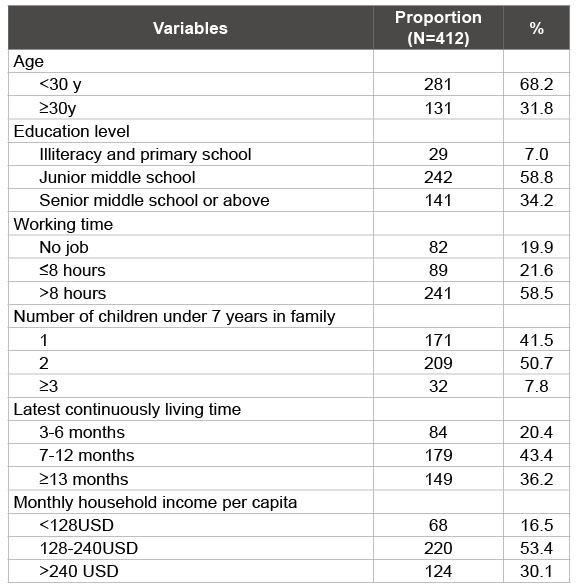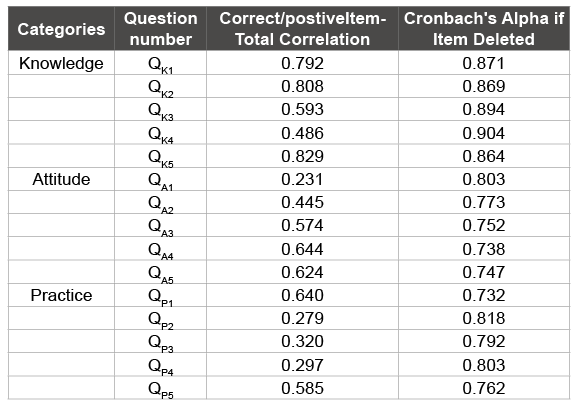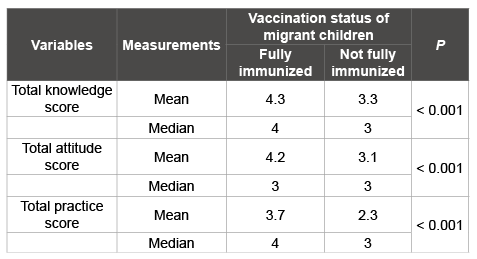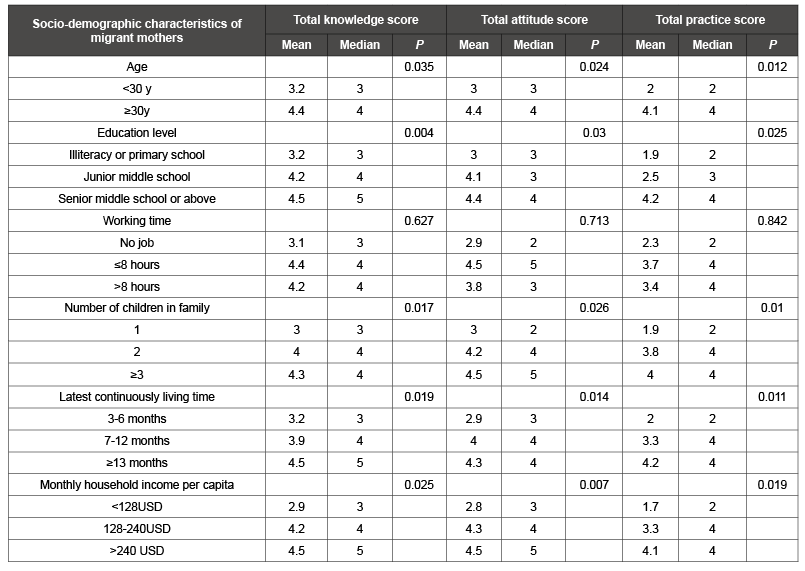
Table 1: Recommended immunization schedule of EPI vaccines in Yiwu city

Yu Hu*1 Shuying Luo2 Linqiao Lou2 Bing Zhang1 Qian Li1
1Institute of Immunization and Prevention, Zhejiang Center for Disease Control and Prevention, No. 3399, Binsheng Road, Binjiang District, Hangzhou 310051, China*Corresponding author: Yu Hu, Institute of Immunization and Prevention, Zhejiang Center for Disease Control and Prevention, No. 3399, Binsheng Road, Binjiang District, Hangzhou 310051, China, Tel: +86-571-8711-5169; E-mail: husix@163.com
Background: Migrant mothers’ knowledge, attitude and practice (KAP) are predictors for children’s vaccination status. Mothers are the main decision makers for childhood health. The objective of this study was to develop a reliable and valid questionnaire to assess the immunization KAP of migrant mothers.
Methods: A cross-sectional survey was conducted among migrant mothers by using a questionnaire which was developed by all co-authors according to the objective of this study. Internal consistency was assessed by using Cronbach’s α coefficient. The test-retest reliability was assessed by using Spearman’s rank correlation coefficient. The construct validity was determined through the known-group validity technique. Kruskal-Wallis and Mann-Whitney tests were applied to examine the disparities of immunization KAP of migrant mothers with different socialdemographic characteristics.
Results: The mean ± standard deviation (SD) of the knowledge score, attitude score and practice score were 7.8 ± 1.4, 7.2 ± 2.2, 6.2 ± 2.3, respectively. Good internal consistency was found for KAP items with Cronbach’s α coefficient of 0.881, 0.755 and 0.783, respectively. The test-retest reliability showed a satisfactory reliability with a Spearman’s rank correlation coefficient value of 0.817. Migrant mothers with ‘fully immunized’ children showed better KAP scores than mothers who did not, suggesting a good construct validity. Mothers’ age, maternal education level, number of children in household, latest continuous living time, and monthly household income per capita were significantly associated with the immunization KAP among migrant mothers.
Conclusions: This study showed an optimal reliability and validity of the questionnaire for measuring the KAP on immunization among migrant mothers in Yiwu and therefore this version can be used in future research.
Immunization; Questionnaire; Knowledge; Attitude; Practice
It is considered that prevention of disease is always economic and effective than cure. Immunization has been demonstrated as an important part in preventive medicine owing to their successes in controlling vaccine-preventable diseases (VPDs) worldwide [1]. The eradication, elimination, and significant reduction of childhood VPDs, as well as the extending of life expectancy in many countries are an outstanding examples of vaccination’s success [2]. Previous report indicated that vaccination could save up to three million childhood lives annually, but there are still another three million lives lost from VPDs [3]. Besides, the advantages of immunization included the prevention of antibiotic resistance and bioterrorism, empower women, safe travelling, promotion of social-economic development and peace, health equity, and extending of the life expectancy [4].
In China, expanded immunization program (EPI) was introduced with four vaccines in 1978, and it continues with 10 vaccine currently (Table 1) [5]. All these vaccines are financed by Chinese central government and are provided free of charge in immunization clinics nationwide. Optimal vaccination coverage is one of the key elements contributed to the success of immunization and children’s good health status. Actually, vaccines are still under-utilized among migrant children. Lower coverage and lower compliance among migrant children in variety of settings have been clearly reported [5-12]. Major barriers towards high coverage of migrant children include lack of knowledge or information on vaccination, poorer awareness or negative attitude towards vaccination, misperceptions or rumors on vaccines safety concerns from media or Internet. These problems were well illustrated in measles outbreaks in some developed countries, where lower vaccination coverage was identified as one of the main reasons. Since the mothers are the primary decision makers on their children’s health, mothers’ knowledge, attitude and practice (KAP) regarding vaccination have a remarkable impact on children’s immunization status [13]. Hence, there is a vital need to evaluate mothers’ KAP on vaccination to improve the coverage, timeliness and completeness on childhood vaccination.

Table 1: Recommended immunization schedule of EPI vaccines in Yiwu city
1. Development of a questionnaire to assess the KAP on immunization based on the determination of its reliability and validity;
2. Using this questionnaire to identify the association between mothers’ KAP on immunization and the vaccination status of their children;
3. Assessment of disparities in migrant mothers’ KAP across sociodemographic characteristics.
The questionnaire was developed by all co-authors after an extensive literature search and it compromised three parts. The first part contained parental socio-demographic data and the second part consisted of five questions regarding knowledge, five questions regarding attitude, and five questions regarding practice. All these questions were “yes/no/don’t know” answer format. The third part contained the vaccination status of migrant children and it was obtained from immunization record booklet kept by mothers or from immunization information system in immunization clinics. Children without any written vaccination certificate were classified as not being vaccinated.
A pilot test of the questionnaire was conducted. Twenty migrant mothers (not included in the final analysis) in Yiwu completed the questionnaire and commented on the questions. These comments were discussed by the researchers and necessary amendments were made accordingly. The final KAP questionnaire version on vaccination was done and made ready for the validity and reliability study.
“Migrants” referred to people living in places other than their hometowns but possessing no local household registration card (Hukou) of their current living address; whereas “registered people” were those residing in their hometowns and owning the local Hukou. Migrant mothers who had a child aged 1-4 years (born from 1 June 2010 to 31 May 2013) and lived in Yiwu were included. Migrant mothers who had a child aged <1 years or >4 years, or lived outside Yiwu were excluded.
This study adopted the questionnaire mentioned above and was conducted in 2014 in Yiwu city, which located in Zhejiang province, eastern China. Yiwu has 13 towns with an area of 1105.5 Km2 and population of 1.9 million (2014 census). Yiwu is famous of its small commodity trade and vibrant free market economy, which had attracted almost one million migrants from rural areas of western China. We collect the demographic data of 13 towns from Yiwu’s statistic bureau. Villages or communities where migrant people accounted for more than half of the total population were selected as our investigation sites and 57 villages and communities were selected. The sampling procedure of this study was based on World Health Organization (WHO)-advocated cluster sampling technique [14]. The sample size was determined based on the following parameters: a desired precision of 5%, an assumption correct/positive response rate of 85% for KAP on immunization, a significance level of 0.05 and a design effect level of 2. Finally, seven eligible migrant mothers per cluster for 57 clusters were determined as our sample size.
We got household list of each investigation site from local administrative office and used the random number to select one household as the first one to be surveyed. After having investigated the first eligible migrant mother and examined her child’s vaccination status, we continued choosing subsequent caregiver located at the right of the previous one until seven eligible migrant mothers for each investigation site were interviewed. If there was more than one eligible child in a household, the vaccination status of the child whose birthday was the closest to the current day was examined.
To evaluate the reliability of this questionnaire, we calculated the Cronbach’s value for the internal consistency reliability testing. The testretest reliability was evaluated by asking a subgroup of target mothers of five clusters (35 mothers in total) after one week period to finish a second copy of the questionnaire. The construct validity of questionnaire was determined through exploring the association between mothers’ KAP and the vaccination status of their children. We used ‘fully immunized’ and ‘not fully immunized’ as a measurement to determine the vaccination status and ‘fully immunized’ was defined as migrant children who had received all the recommended vaccines (doses) according to age at the surveyed time(Up-to-Date and Not Up-to-Date).
The percentages of socio-demographic variables of migrant mothers such as age, gender, education level, occupation status, household income per month, number of children under 7 years were presented by descriptive analysis. Scoring of the questions on KAP was defined by giving one point for each correct/positive response and zero for incorrect/ negative response or for no response. The means, medians and standard deviations (SD) were calculated for total scores of knowledge, attitude and practice on immunization, respectively. These total scores were treated as continuous variables and the range of these scores was from 0 to 5. Reliability was tested for internal consistency and a correct/postive item-total correlation by using Cronbach’s α coefficient. Spearman’s rank correlation coefficient was used to obtain test-retest reliability. Knowngroup validity was assessed through the association of vaccination status, total knowledge score, total attitude score and total practice score by adopting the Mann-Whitney test. Kruskal-Wallis and Mann-Whitney tests were applied to examine the disparities among groups for nonparametric distribution.
Ethical approval for the study was obtained from ethical review board of Zhejiang Provincial Center for Disease Control and Prevention. All mothers in the sample read a cover letter describing the objectives of this study and the time needed to finish the questionnaire and received written informed consent for their participation. This cover letter was signed by them once there was a decision to participate.
A total of 412 migrant mothers with a child aged 1-4 years were surveyed in this study. We found that 68.2% of surveyed mothers were under 30 years old, and the vast majority of them had a junior middle school or above (93.0%). Of all mothers, 330 had a job (80%). Among those 241 worked more than eight hours a day. We found 58.5% of the surveyed mothers had more than two children and only 36.2% of them had lived in the investigation sites for more than one year. The proportion of monthly house hold income per capita less than 128USD was 16.5% (Table 2).

Table 2: Social demographic characteristics of surveyed mothers who had migrant children aged 1-4 years in Yiwu
The mean ± SD for the total knowledge score, total attitude score and total practice score were 7.8 ± 1.4, 7.2 ± 2.2, 6.2 ± 2.3, respectively. Internal consistency was determined for the five questions of knowledge, five questions of attitude and five questions of practice with Cronbach’s α coefficient of 0.881, 0.755 and 0.783, respectively which implicated optimal reliability of all instruments. (Table 3) summarized the correct/ postive item-total correlations between each five questions of knowledge, attitude and practice. The test-retest reliability with an interval of one week for migrant mothers from five investigation sites showed a satisfactory reliability with a Spearman’s rank correlation coefficient value of 0.817, P<0.001.

Table 3: Reliability test of each five questions of the knowledge, attitude and practice scale on immunization
‘Fully immunized’ status of migrant children was significantly associated with total knowledge score, total attitude score and total practice score. Migrant mothers with a ‘fully immunized’ child showed higher knowledge, attitude and practice scores than mothers with ‘not fully immunized’ child, suggesting a good construct validity (Table 4).

Table 4: Association between vaccination status of migrant children and total KAP scores
The mothers total knowledge score was significantly associated with the total attitude score (Spearman’s rank correlation coefficient 0.416, P= 0.039) and the total practice score (Spearman’s rank correlation coefficient 0.339, P=0.028). Similarly, we also found the total attitude score was significantly associated with the total practice score (Spearman’s rank correlation coefficient 0.461, P=0.047). Significant disparities were found in total scores of knowledge, attitude and practice on immunization among migrant mothers with different socio-demographic characteristics. These impact factors included mothers’ age, maternal education level, number of children in household, latest continuous living time in intervention sites, and monthly household income per capita (Table 5).

Table 5: Total KAP scores disparities among different socio-demographic characteristics of migrant mothers
One of objectives of this study was to develop a reliable and valid questionnaire covering main aspects of migrant mothers’ KAP on immunization, which could be applied to explore the association between migrant mothers’ KAP on immunization and vaccination status of their children in further researches. Although we had conducted KAP on immunization among migrant mothers before, this was the first time we used a questionnaire which had been tested for the reliability and validity. Many tools or questionnaires for assessing the KAP on immunization have been developed in other countries [15-20], but it should be careful to interpret the results from surveys which used these tools or questionnaire. The main reason for that was many determinants could impact mothers’ KAP on immunization, such as their different socio-demographic characteristics or culture beliefs.
The questionnaire in our study showed optimal internal consistency reliability for both knowledge, attitude and practice on immunization (exceeded the minimum α-coefficient of 0.70). These findings were echoed by the similar results of test-retest reliability. The known-group validity assessment showed migrant mothers of children who had fullyimmunized had significantly KAP level than those who had not fully immunized according to their current age. These findings indicated that the questionnaire also had a good construct validity. Indeed, the developed questionnaire truly assessed the KAP level on immunization among migrant mothers and the findings of this study showed how migrant mothers’ knowledge, attitude and practice could influence the immunization status of their children.
Our study found positive correlations among migrant mothers’ knowledge level, attitude level and practice level. It was consisted with previous reports conducted national and abroad and these reports showed that mothers who had adequate of immunization knowledge also had positive attitude and practice regarding immunization [8,21-25]. Migrant mothers who were 30 years or more and had more than one child showed significantly higher immunization KAP scores than younger mothers or mothers with only one child. These findings was consisted with previous reports [26-29] and these results might be due to elder mothers or mothers with more than one child had more life experience on vaccination service and better understanding on vaccination policy. This study found that mothers with higher education level had higher KAP levels on immunization as was found in a study in the USA [30]. We speculated that mothers with higher education level might have a better awareness of children’s health and understand of vaccination policy much more easily. We also found mothers with a better socio-economic status, such as having occupations and a better monthly income, and number of children in household could had higher KAP level on immunization. A study by Bobo found that mothers who had a lower level of education, a lower income and more children tended to have under-immunized children [31]. These results implicated that a stable occupation or a good income frees the household from the struggle of finding work to survive, which encouraged mothers paying more attention to the vaccination for their children. Therefore, there is concern for families with a greater number of preschool children and a lower income who may have a greater risk of immunization errors. We found that the duration of continuous living investigation sites could affect the mothers’ KAP level on immunization. It probably reflected that recent and settled migrant mother had a different awareness and access to vaccination service [32], although the availability of vaccination services was equal and these migrant mothers lived in the same area. Based on these findings, we speculated the new migrant mothers would face with the challenge to adapt the new living and socialcultural circumstances while the settled migrants were familiar with these environment and were better able to avail themselves of vaccination service. This phenomenon was also found in other public health service, such as post-natal visits [33].
Surveillance towards migrant mothers’ KAP status on immunization was useful for immunization policy makers to design or improve the strategy on health education and social mobilization on immunization. Those migrant children whose mothers had suboptimal KAP level on immunization must be treated as the key group to maintain or improve vaccination coverage through effective interventions such as Reaching Every District (RED), out-reach vaccination services and health education [34-36].
The main limitation of this study was that the sample was smaller than those in previous reports and the findings of our study could not generalized to the migrant mothers who did not include in this study. Therefore, the results need to be interpreted within the context of study limitations.
This study found that the developed questionnaire was a reliable and valid tool for assessing the immunization KAP level of migrant mothers in Yiwu. This questionnaire should be used in future researches on immunization KAP of migrants and allow for better understanding of the association between the immunization KAP of migrant mothers and their children vaccination status.
The authors declare no conflict of interest.
We would like to thank the Yiwu health bureau for their invaluable support, relative community leaders for their constant help. In addition, we would like to thank all the health workers from Yiwu CDC who conducted the interviews and data collection.
Download Provisional PDF Here
Article Type: Research Article
Citation: Yu Hu, Shuying Luo, Linqiao Lou, Bing Zhang, Qian Li (2016) Knowledge, Attitude and Practice on Immunization Among Migrant Mothers: A Questionnaire Development and Field Application. Int J Vaccine Immunizat 2(1): doi http://dx.doi.org/10.16966/2470-9948.106
Copyright: © 2016 Yu Hu, et al. This is an open-access article distributed under the terms of the Creative Commons Attribution License, which permits unrestricted use, distribution, and reproduction in any medium, provided the original author and source are credited.
Publication history:
All Sci Forschen Journals are Open Access